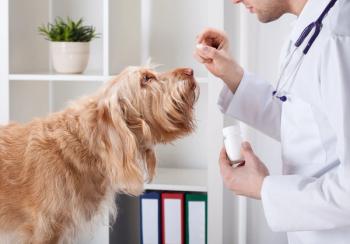
Examining the role of veterinary technicians
Editor's Note: As the delivery of veterinary care becomes more sophisticated, the need to better utilize the skills of registered veterinary technicians increases, some veterinarians say.
Editor's Note: As the delivery of veterinary care becomes more sophisticated, the need to better utilize the skills of registered veterinary technicians increases, some veterinarians say.
Enhancing the technicians' role might relieve time pressure for doctors and keep them engaged in the field, but there are limits. At this year's DVM Newsmakers' Summit at CVC East in Baltimore, DVM Newsmagazine assembled a panel of leaders from state boards of veterinary medicine and technician associations to examine key issues on this subject. Results of that discussion will be presented in three parts, starting this month and continuing with DVM Newsmagazine's August and September issues. Next month the panelists address the regulatory/legal realities.
THE PANELISTS
Moderator: Greg Dennis, JD, of Kent T. Perry & Co. in Overland Park, Kan., is a charter member and former president of the American Veterinary Medical Law Association and served on AVMA's Model Veterinary Practice Act Task Force and the Legal Status of Animals Task Force. He co-edits the veterinary reports of the Animal Legal Report Services.
Sue Geranen is executive officer of the California Veterinary Medical Board, a consumer watchdog agency that regulates the development and maintenance of professional standards, oversees licensing of veterinarians and registered veterinary technicians and helps enforce the California Veterinary Medicine Practice Act.
Dr. Richard Johnson owns the Animal Medical Center (AMC) of East County, a 16-doctor practice in El Cajon, Calif. A 1977 graduate of UC-Davis, he chairs the RVTC commission of the California Veterinary Medical Board. He previously was a surgical resident at the AMC and was an associate professor at the University of Illinois.
Dr. Sherbyn Ostrich is past president of the American Veterinary Medical Association and the Pennsylvania Veterinary Medical Association. A private practitioner for 30 years, he was the first recipient of the University of Pennsylvania's Bellwether Award for leadership. He is a charter member of the National Commission on Veterinary Economic Issues.
Teri Raffel, CVT, is president of the National Association of Veterinary Technicians in America. She teaches veterinary technology at the Madison Area Technical College in Madison, Wis.
Deb Coleman is an RVT. She serves on the board of regents for the Academy of Veterinary Technician Anesthetists and is employed at the Iowa State University College of Veterinary Medicine.
Mr. Dennis: Looking at the duties of veterinary technicians today, what's driving the move behind expanding or changing their role? Is it society's expectations? Are veterinarians and technicians adapting to changes in the profession? What about the increased use of sophisticated medical equipment? Should that be used by technicians or by the veterinarian?
On the regulatory side, how is the practice of veterinary medicine defined? Who is or is not a veterinary technician? The title often is used generically, but it has significant legal implications. Who is responsible for the care provided by a technician? What happens in emergency situations?
The definition of required supervision varies throughout the country. One state will require it, another may not. What can a veterinarian lawfully delegate to a technician, and should those duties be changed? Who's responsible for a technician's mistake?
In law, we have a concept called negligent hiring retention, called an unfit employee. We'll discuss that as it applies to veterinary technicians.
Restraint of animals: Who should restrain animals – the client or a technician? Who may discuss treatment options, the technician or the veterinarian?
Record-keeping requirements: How are veterinary technicians involved in that? What about the duty of a technician, if any, to maintain the confidentiality of records and information?
Can technicians have an ownership interest in veterinary practices? We have a number of such issues that recently arose in California.
Finally, the last section is on retention of veterinary technicians. We'll discuss their mobility from one practice to another, their specialization, how their roles within the practice mesh with those of other employees.
Let's first discuss how the role of veterinary technicians is changing in the United States. I've been practicing veterinary law for about 20 years, and have seen noticeable changes. How is this field evolving?
Dr. Ostrich: When I started practicing veterinary medicine, there were no trained veterinary technicians, except at Angell Memorial Hospital in Boston. I was fortunate enough, in my third year of practice, to recruit one of their nurses to work for me. I said to myself, 'I never want to go back to what I had been doing.' She was very well trained. She put the tube in a dog's trachea quicker than any veterinarian that I ever hired at that point. She placed IVs better than most veterinarians coming out of school. I was really happy to see this profession of veterinary technology start to evolve.
But in that light, maybe this is why we're in a dilemma. We trained our own help in those days. They became very proficient. You can't really say you have to be a technician with a degree to perform some of these procedures. However, to perform them right, to understand what they're doing and why they're doing it, you need trained technicians. If a person doesn't really think about why they're doing it, they cannot make excellent decisions.
I've always hired technicians. I had five technicians in the first practice I started. Everybody said, 'You're crazy paying that kind of money to hire technicians.' I said, 'I might be crazy, but I sleep well at night.'
There have been problems with grandfathering people who were well trained to perform these roles. Even in the university where I was trained, they didn't have specialty degrees for technicians. They were trained by the university staff. What do you do with people you've trained and who do a good job? Suddenly a law is passed, and they can no longer do that job. I don't know how to answer that except to help them somehow get the training. Distance learning might be the way to go. There are accredited distance-learning programs. But they're not quite the same. Unless you have someone in your practice who will complement the person undergoing distance-learning training in veterinary technology, it's a rough go.
Ms. Geranen: My first question is, what is the role of the veterinary technician in the delivery of health care? How do you define the job? What are the duties that are the dividing line between designations of registered, certified or licensed technicians? I'm going to refer to this occupation as registered veterinary technicians, because that's what we do in California.
When we first started that profession back in 1976 in California, they were called animal-health technicians (AHTs), and there was a three-year grandfather clause. Since that first input of registered veterinary technicians, we've gone to a population of about 3,500 in the state. It's stayed at that number. We're actually considering doing another limited grandfather clause to see if there are people a veterinarian could certify for competencies. Those individuals would need the equivalent of five years of practice. For a profession, you have to have numbers. If there are people out there that you could bring into the profession on a one-time provision, we're looking at the pros and cons of that.
In Georgia, they're trying this grandfather clause. Has it increased the overall numbers? We're thinking of trying it during a one-time, 12-to 18-month period. There are many distance-learning and RVT schools – in California we have six new schools. Years ago, we had seven approved schools in six locations. It was impossible for people who were already working in the profession. And yet those are the people you want. They have the appropriate background. You get new people in who have never worked in veterinary hospitals, but they couldn't leave their job to go back to school.
So an alternate route was created, which was a combination of education that can be obtained outside an approved program, plus some experience. That's been pretty effective. The committee has updated the category and the task list. We're looking at the task list more as a certification of competencies. It's not just five years of experience. The veterinarian is actually certifying that the candidate has performed to a level that they feel is sufficient to qualify for that experience.
Mr. Dennis: Across most of the country there seems to be a move to expand the role or the duty or permissible tasks that a veterinary technician – even lay employees – can do. Any discussion on what the motivation is? Why is there this pressure to allow more services traditionally provided by the veterinarian to be provided by the veterinary technician?
Dr. Johnson: I've always looked at the allied professions –physicians' assistants and nurses – in terms of what they're capable of doing for the MDs. To me, almost every allied profession has educated, trained support staff. I personally don't think the changes that have occurred for our profession have been significant enough. Maybe that's just because they're not happening fast enough for me.
We recently hired an RN in our practice as a hospital administrator. She's CEO of the hospital. She works with the doctors, and she has experience working with the veterinarians. She is responsible for most of the human-resources functions with our staff. We now have 145 employees. To me this shows the impact of numbers of people, and we don't pay huge salaries. We just built a new building, so there are other issues.
How many people are interested in working with animals? I think the population is out there, at least in California. But even with the alternate route, we don't have good mechanisms to get those people who have dedicated their lives to continuing to help us help animals. We don't have mechanisms to get them licensed as well as we should. A lot of the training programs we talk about can cost $18,000 to $20,000. The AAHA program is about $15,000. They are limiting due to price. How do you pay someone $8 an hour, $10 an hour or $15 an hour and say, 'I want you to go through this $20,000 program, and you're going to become an RVT or a licensed tech making $13 an hour?' "
It is starting to change. We are beginning to see distance-learning programs develop. If they could be a little more affordable, it would lighten up many of the restrictions, because people are interested in the profession.
We just have to find better mechanisms to get them trained. Then we need to support it through salaries and job tasks. You're not going to go to school for that period of time, become licensed, and then clean cages, hold animals, put in IV catheters and give injections. There are a lot of issues that are all interwoven. I would encourage all of you to start looking at these issues in your individual states when you talk about what is a veterinary technician. First question you have to ask is, where? We have to start looking at some of these other issues and how to get your profession up to the par that it needs to be.
Dr. Ostrich: One of the most important things we have to do for veterinary technology is to increase the depth of the program. For example, there should be master's degrees and even PhD degrees given in veterinary technology. There's a wealth of knowledge out there in human medicine that can be brought back to the veterinary profession by the right people.
For example, I had a child that at 2 years of age had to go to the children's hospital to have a kidney operation. At that age, we stayed with them overnight. I had the opportunity to walk around the hospital wards, chat with the nurses, etc. It was the first time I ever saw a butterfly catheter placed in a baby. I saw little arms wrapped up so they wouldn't bend them to affect their IVs. I never thought of doing that with animals before. It really impressed me.
We have to send somebody into this to learn and bring it back to the veterinary profession. I'm sure there's a depth of knowledge out there so that we easily could have PhD programs in veterinary technology. That raises their level of self-respect and worth to the hospital. In my area of Pennsylvania, we now have a program to train assistants. They don't go any further than that. We've had a few of these folks come into our practice and help. Many of them I hope will go on to veterinary technology school and actually become licensed technicians. If people are willing to go to a school for a year to become an assistant to a veterinary technician, that's a step in the right direction.
Newsletter
From exam room tips to practice management insights, get trusted veterinary news delivered straight to your inbox—subscribe to dvm360.





